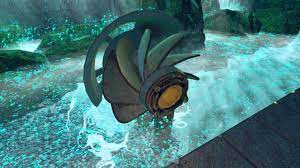The global quest for sustainable energy solutions has led to the development of groundbreaking technologies like the Techtonica Water Wheel. This article explores the workings and potential of this innovative device in our pursuit of sustainable energy generation.
Understanding the Techtonica Water Wheel
The Techtonica Water Wheel is a hydroelectric system designed to harness the power of flowing water, converting it into electricity. Unlike traditional hydroelectric dams, which can have significant environmental impacts, this technology offers a more eco-friendly approach to energy generation.
The Mechanics Behind the Water Wheel
At its core, the Techtonica Water Wheel operates on a simple yet effective principle. As water flows through the wheel, the mechanical force causes it to rotate, thus driving a generator that produces electricity. The wheel’s design allows it to capture energy from even slow-moving water sources, making it adaptable to various environments.
Environmental Impact
One of the most significant advantages of the Techtonica Water Wheel is its minimal environmental footprint. Unlike large dams that can disrupt ecosystems and fish habitats, these water wheels have a much smaller impact on the environment. They operate without the need for extensive reservoirs and are less harmful to aquatic life.
Applications of Techtonica Water Wheel
The versatility of Techtonica Water Wheels is remarkable. They can be employed in a range of settings, from rural areas with limited access to conventional power grids to urban centers seeking clean energy alternatives.
Efficiency and Performance
The efficiency of the Techtonica Water Wheel is a key factor in its appeal. It can generate electricity consistently, even with varying water flow rates, making it a reliable source of power.
Advantages Over Traditional Hydroelectric Systems
Compared to traditional hydroelectric systems, Techtonica Water Wheels offer several advantages. They are cost-effective, environmentally friendly, and require less infrastructure, making them an attractive option for sustainable energy projects.
Challenges and Limitations
While Techtonica Water Wheels hold promise, they are not without challenges. Factors such as maintenance, water source availability, and geographic suitability must be considered when implementing these systems.
Techtonica Water Wheel Projects Worldwide
Around the world, Techtonica Water Wheel projects are gaining momentum. From remote villages in developing countries to advanced economies, these systems are making a difference in how communities access electricity.
Future Prospects and Innovations
As technology continues to advance, we can expect to see improvements in Techtonica Water Wheel designs and efficiency. These innovations will further enhance their contribution to sustainable energy generation.
Economic Viability
The economic aspect of adopting Techtonica Water Wheels is another crucial factor. Their affordability and potential for long-term cost savings make them an attractive investment for both governments and private entities.
Government Initiatives and Incentives
Many governments are recognizing the importance of renewable energy sources and are providing incentives for the adoption of Techtonica Water Wheels. These initiatives aim to accelerate the transition to sustainable energy.
Conclusion
The Techtonica Water Wheel represents a promising step towards a more sustainable future. Its efficiency, minimal environmental impact, and adaptability make it a valuable addition to the renewable energy landscape. As we seek cleaner and greener energy sources, innovations like the Techtonica Water Wheel will play a pivotal role in our journey towards a more sustainable world.






Add comment